To master triangular composition in smartphone photography, focus on arranging key elements in a triangular shape. Look for natural triangles in landscapes, or create them with subjects and leading lines. Position your main subject at one point of the triangle and use the rule of thirds for balance. Enhance depth by incorporating foreground elements and diagonal lines. When editing, crop to refine the triangular arrangement and use color grading to emphasize key elements. Practice identifying and utilizing triangular shapes in various scenes to improve your skills. By mastering this technique, you'll transform ordinary snapshots into visually compelling images that guide the viewer's eye.
Understanding Triangular Composition
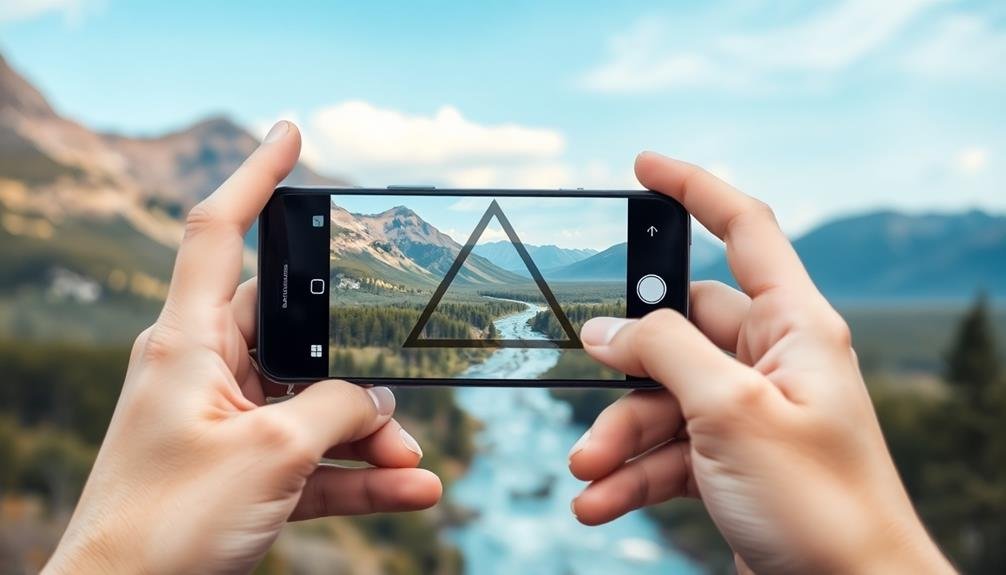
Triangular composition is a powerful tool in smartphone photography that can elevate your images from ordinary to eye-catching. This technique involves arranging key elements of your photo in a triangular shape, creating a sense of balance and visual interest.
It's based on the principle that our eyes naturally follow lines and shapes within an image. To use triangular composition, you'll need to identify three main points of interest in your scene. These could be objects, people, or even areas of contrasting light and shadow.
Imagine connecting these points with invisible lines to form a triangle. The triangle doesn't have to be perfect or equilateral; it can be any shape or size as long as it's recognizable.
You can create triangles in various ways: through actual triangular objects, implied lines, or by positioning subjects strategically. Sometimes, you'll find natural triangles in architecture or landscapes.
Other times, you'll need to move around or adjust your framing to create the desired shape. Remember, the goal is to guide the viewer's eye through the image, creating a dynamic and engaging visual journey.
Finding Triangles in Nature
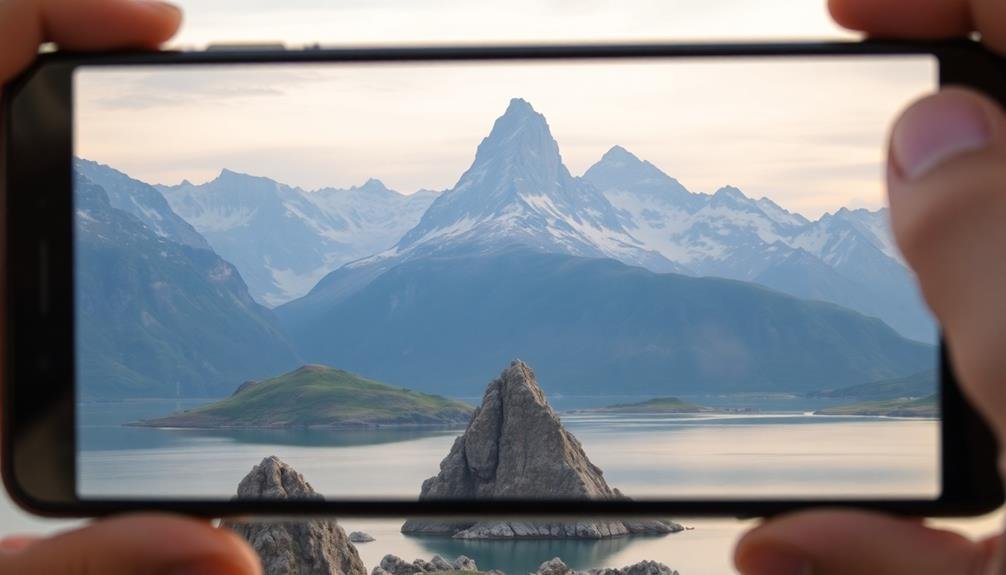
Nature provides an abundance of triangular shapes, making it an ideal playground for practicing this composition technique. You'll find triangles in mountains, trees, and rock formations. Look for tall, pointed structures that naturally form triangular shapes against the sky or surrounding landscape.
Rivers and streams often create triangular patterns as they wind through valleys or split into tributaries.
In flora, many leaves and flowers exhibit triangular shapes. Ferns, for example, have fronds that form multiple small triangles within a larger triangular structure. Trees can create triangular compositions when their trunks diverge into branches or when you frame them against other elements in the scene.
Don't overlook man-made structures in natural settings. Bridges, piers, and docks often incorporate triangular designs that can add interest to your compositions.
Even shadows cast by natural objects can create compelling triangular shapes, especially during early morning or late afternoon when the sun is low on the horizon.
To find triangles in nature, train your eye to look for converging lines and angular shapes. You'll soon discover that triangles are everywhere, waiting to be captured in your smartphone photography.
Creating Triangles With Subjects
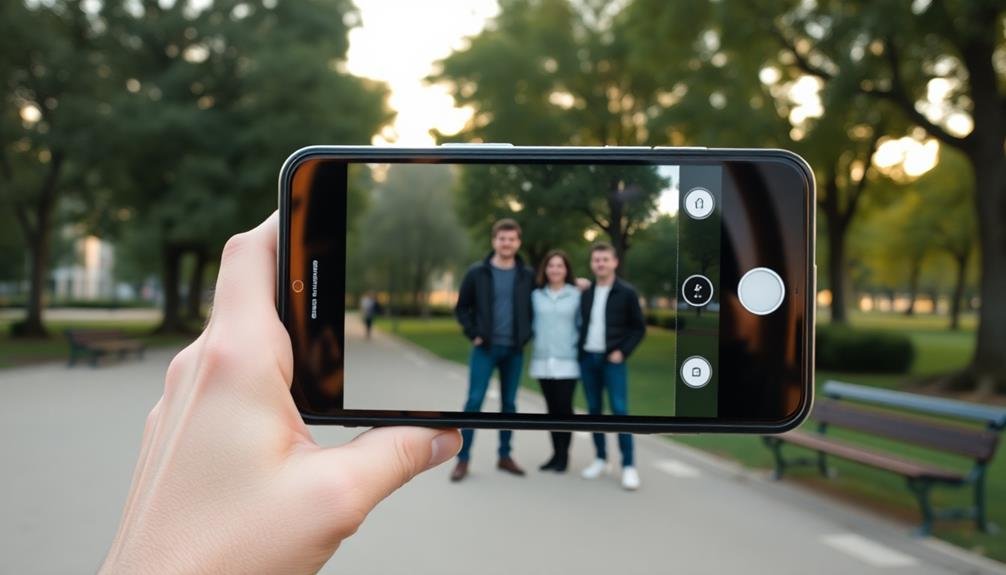
You can create powerful triangular compositions by strategically positioning your subjects.
When photographing people, try arranging them in a triangle formation to add depth and visual interest to your smartphone shots.
In landscape photography, you'll often find natural triangles formed by mountains, trees, or other elements that you can use as the foundation for your composition.
Arranging People in Triangles
Arranging people in triangular formations can dramatically enhance the visual impact of your smartphone photos. When composing group shots, position your subjects at different heights to create a natural triangle shape. You can achieve this by having some people sit or kneel while others stand, or by using stairs or uneven terrain to vary their heights.
Remember to keep the most important person or focal point at the apex of the triangle.
For portraits of two people, place them at different distances from the camera, with one slightly in front of the other. This creates a subtle triangular arrangement that adds depth to your image.
When photographing three subjects, position them in a classic triangular formation, with two people forming the base and one at the top.
Consider these tips when arranging people in triangles:
- Use props or furniture to help create triangular shapes
- Experiment with diagonal lines to lead the eye through the composition
- Incorporate negative space to balance the triangular arrangement
Natural Triangles in Landscapes
How can landscapes offer natural triangular compositions for your smartphone photography? Nature often provides ready-made triangular shapes that you can leverage for stunning shots. Look for mountains, hills, or rock formations that create triangular silhouettes against the sky. Trees, especially lone ones on hilltops, can form perfect triangles with their branches.
Rivers and roads winding through landscapes often create triangular shapes as they disappear into the distance. Pay attention to reflections in water bodies, which can mirror triangular elements and double their impact. Shorelines and beaches can form triangular compositions where land meets water and sky.
| Element | Triangular Potential |
|---|---|
| Mountains | Peaks and slopes |
| Trees | Conical shapes, branches |
| Rivers | Winding paths |
| Roads | Converging lines |
To emphasize these natural triangles, position your smartphone to align the edges of the frame with the triangular elements. Use leading lines to guide the viewer's eye through the composition. Don't forget to contemplate the rule of thirds when placing your triangular subjects within the frame. By recognizing and capturing these natural triangles, you'll elevate your landscape photography and create more dynamic, visually appealing images with your smartphone.
Using Leading Lines
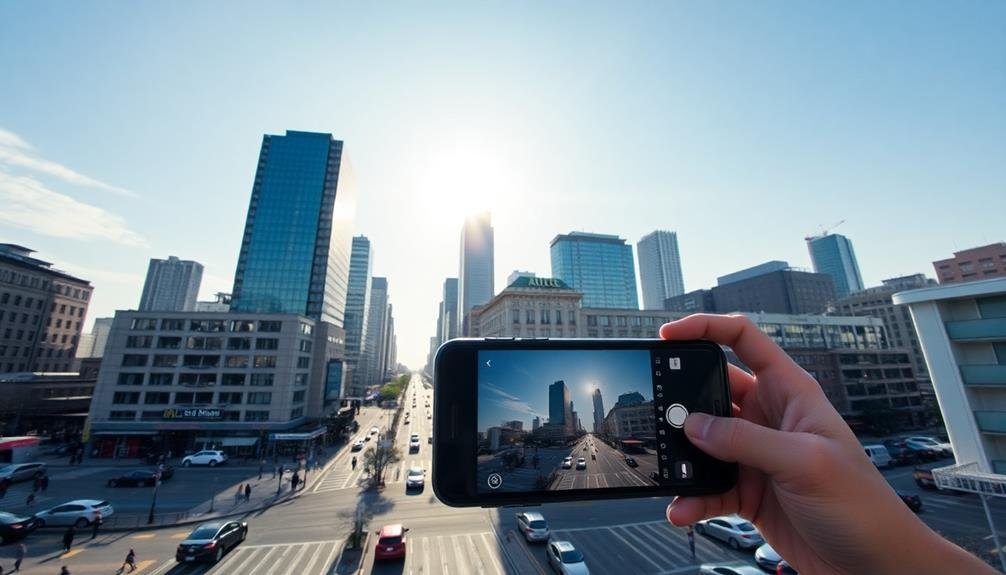
To enhance your triangular compositions, you'll want to leverage leading lines effectively.
Start by identifying natural lines in your scene, such as roads, fences, or architectural elements.
Position these diagonal elements strategically to guide the viewer's eye towards your main subject, creating a visual flow that reinforces the triangular structure of your image.
Identify Natural Lines
Natural lines are everywhere in our surroundings, waiting to be discovered and incorporated into your triangular compositions. As you frame your smartphone photos, train your eye to spot these inherent lines in the environment.
Look for architectural elements like staircases, bridges, or building edges that can guide the viewer's gaze. In nature, tree trunks, mountain ridges, or flowing rivers can serve as powerful linear elements.
When identifying natural lines, consider their direction and how they interact with your subject. Horizontal lines can create a sense of stability, while vertical lines convey strength and height. Diagonal lines add dynamism and movement to your image.
Remember that lines don't always have to be straight; curved lines can add a graceful flow to your composition.
To effectively use natural lines in triangular compositions:
- Align your subject with intersecting lines to create a focal point
- Use converging lines to draw attention to a specific area
- Experiment with contrasting line directions to create visual tension
Position Diagonal Elements
Building on your newfound ability to identify natural lines, let's focus on positioning diagonal elements to create powerful leading lines in your triangular compositions. Diagonal lines are particularly effective in guiding the viewer's eye through your smartphone photos, adding depth and dynamism to your images.
To position diagonal elements effectively, start by scanning your scene for natural diagonals like roads, fences, or architectural features. Once you've identified these elements, align your smartphone to emphasize their angular nature.
Experiment with different angles and perspectives to maximize the impact of these diagonals. Don't hesitate to use the rule of thirds grid on your smartphone camera to help position these diagonal elements.
Try placing the start of the diagonal line at one of the intersecting points and let it lead towards the opposite corner. This technique can create a strong sense of movement and draw attention to your main subject.
Create Visual Flow
Once you've mastered positioning diagonal elements, it's time to harness their power to create visual flow in your triangular compositions. Leading lines are essential for guiding the viewer's eye through your image, creating a sense of depth and movement. In triangular compositions, these lines often form the edges of your triangle, directing attention to key points of interest.
To create effective visual flow:
- Use natural lines in your environment, such as roads, fences, or coastlines
- Incorporate man-made structures like buildings, bridges, or staircases
- Leverage shadows or light patterns to form subtle directional cues
When framing your shot, position these leading lines to point towards your main subject or to create a path between multiple focal points.
You'll want to experiment with different angles and perspectives to find the most compelling arrangement. Don't be afraid to move around or change your shooting position to align these elements perfectly.
Balancing Elements Within Triangles
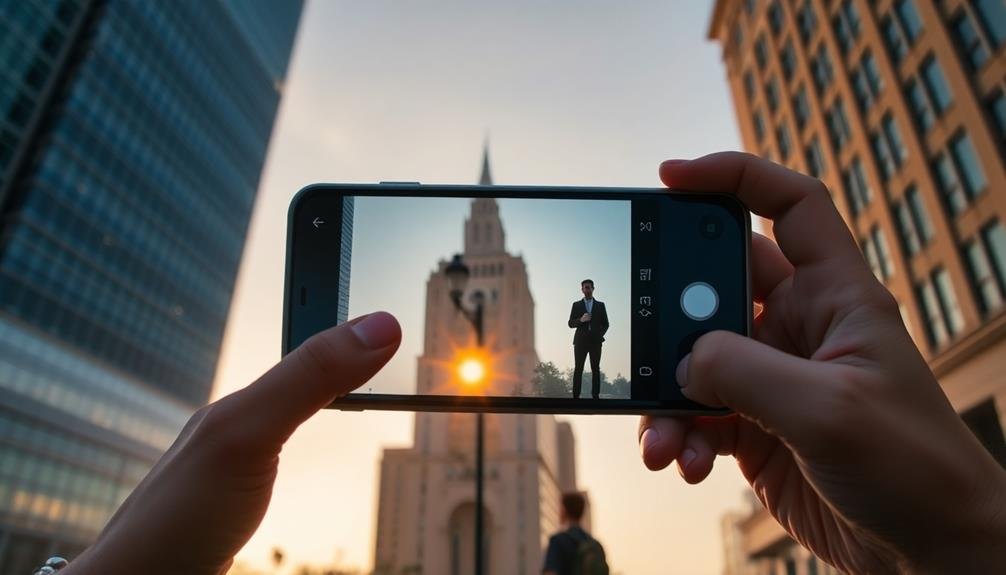
In light of the triangular composition, balancing elements within the frame becomes essential for creating visually appealing smartphone photos. When you're arranging your shot, reflect on the weight and importance of each element within the triangle. Aim to distribute visual interest evenly across the three points or sides of the triangle.
Start by identifying your main subject and placing it at one of the triangle's points. Then, look for secondary elements to position at the other two points. These can be contrasting objects, complementary colors, or even negative space. Remember that balance doesn't always mean symmetry; asymmetrical arrangements can be just as compelling.
Pay attention to the size, color, and texture of the elements you're including. A small, bright object might balance out a larger, darker one. Use leading lines or natural patterns to guide the viewer's eye between the balanced elements.
Don't forget to reflect on the background; it should support your triangular composition without overpowering it.
Experiment with different triangular shapes – equilateral, isosceles, or scalene – to see which best suits your subject and creates the most harmonious balance. With practice, you'll develop an intuitive sense for balancing elements within triangular compositions.
Applying the Rule of Thirds

Despite its simplicity, the rule of thirds can greatly enhance your triangular compositions in smartphone photography. By dividing your frame into a 3×3 grid, you'll create intersection points that naturally draw the viewer's eye. When combining this principle with triangular composition, you'll add depth and interest to your images.
To apply the rule of thirds to triangular compositions:
- Place key elements of your triangle at grid intersections
- Align the base or sides of your triangle with horizontal or vertical grid lines
- Use negative space in one or more grid sections to balance your composition
As you frame your shot, position the main subject or focal point at one of the grid intersections. This creates a sense of balance and tension within the image. You can also use the grid lines to guide the placement of your triangle's edges, creating a harmonious relationship between the rule of thirds and triangular composition.
Don't be afraid to experiment with different placements and arrangements. Sometimes, intentionally breaking the rule of thirds can lead to striking and unique compositions.
The key is to use these guidelines as a starting point, then trust your artistic instincts to create compelling smartphone photographs.
Enhancing Depth With Triangles

Triangular composition isn't just about arranging elements; it's a powerful tool for enhancing depth in your smartphone photos. By strategically placing objects or lines to form triangles within your frame, you'll create a sense of dimension that draws viewers into the image.
To enhance depth using triangles:
- Use foreground elements to form the base of a triangle, leading the eye towards the background.
- Incorporate diagonal lines that converge towards a focal point, creating a sense of perspective.
- Leverage natural triangular shapes in architecture or landscapes to add depth.
- Experiment with low angles to emphasize triangular forms and create a more dynamic composition.
| Technique | Effect on Depth |
|---|---|
| Foreground Base | Establishes layers |
| Converging Lines | Creates perspective |
| Natural Shapes | Adds visual interest |
| Low Angles | Emphasizes dimension |
Editing for Triangular Emphasis

Once you've captured your image using triangular composition, post-processing can further enhance this visual structure. Use editing tools to accentuate the triangular elements in your photo. Adjust contrast and brightness to make the triangular shapes more prominent.
You can also use selective editing to draw attention to specific areas within the triangle.
Consider these techniques to emphasize triangular composition:
- Crop your image to perfect the triangular arrangement
- Apply a vignette effect to guide the viewer's eye towards the central triangle
- Use color grading to create visual contrast between triangular elements
Don't be afraid to experiment with different editing styles. You might find that desaturating certain areas of the image helps to highlight the triangular composition.
Alternatively, increasing the vibrance of key elements within the triangle can make them pop. Remember, the goal is to subtly enhance the existing triangular structure, not to create an artificial one.
Frequently Asked Questions
Can Triangular Composition Work for Portrait Photography on Smartphones?
Yes, triangular composition can work well for portrait photography on smartphones. You'll find it adds depth and interest to your shots. Try positioning your subject's eyes and shoulders to form a triangle, creating a dynamic and engaging portrait.
Are There Apps Specifically Designed to Help With Triangular Composition?
While there aren't apps specifically for triangular composition, you'll find many camera apps with grid overlays that can help. You can use these grids to guide your triangular composition. Practice and experimentation are your best tools.
How Does Triangular Composition Differ Between Landscape and Urban Photography?
You'll find triangular composition differs in landscapes and urban settings. In nature, you're using organic shapes like mountains or trees. In cities, you're working with man-made structures like buildings and streets to create your triangles.
Can Triangular Composition Be Effectively Combined With Other Composition Techniques?
You can definitely combine triangular composition with other techniques. Try pairing it with leading lines, the rule of thirds, or symmetry. It's versatile and can enhance your framing, create depth, and guide the viewer's eye effectively.
What Common Mistakes Should Beginners Avoid When Using Triangular Composition?
You'll want to avoid forcing triangles where they don't naturally exist. Don't neglect other compositional elements, and don't rely solely on triangles. Be careful not to create distracting or unbalanced compositions by overusing this technique.
In Summary
You've now mastered the art of triangular composition in smartphone photography. Remember, it's not just about finding triangles, but creating them with your subjects and surroundings. Use leading lines, balance elements, and apply the rule of thirds to enhance your shots. Don't forget to experiment with depth and edit your photos to emphasize triangular shapes. With practice, you'll naturally incorporate this powerful technique into your smartphone photography, elevating your images to new heights.





Leave a Reply